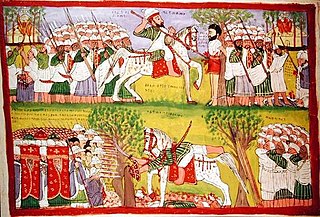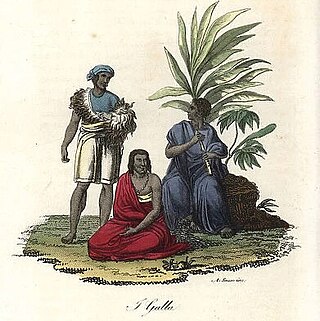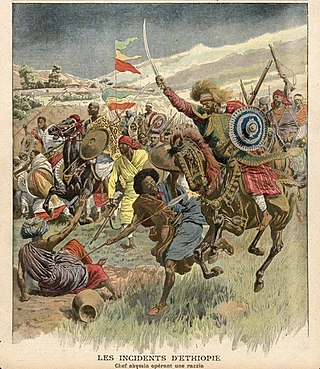
Harar, known historically by the indigenous as Harar-Gey or simply Gey, is a walled city in eastern Ethiopia. It is also known in Arabic as the City of Saints.

The Adal Sultanate, also known as the Adal Empire or Bar Saʿad dīn, was a medieval Sunni Muslim Empire which was located in the Horn of Africa. It was founded by Sabr ad-Din III on the Harar plateau in Adal after the fall of the Sultanate of Ifat. The kingdom flourished c. 1415 to 1577. At its height, the polity under Sultan Badlay controlled the territory stretching from Cape Guardafui in Somalia to the port city of Suakin in Sudan. The Adal Empire maintained a robust commercial and political relationship with the Ottoman Empire. Sultanate of Adal was alternatively known as the federation of Zeila.
Hadiya also known as Adea or Hadia was a medieval Muslim state in the southern part of its realm located south of Shewa and west of Sharkha. The Hadiya Muslim state mainly composed of Cushitic Hadiyya proper, Halaba, Kebena people as well as Semitic Sil'te and other tongues related to Harari language. Hadiya was historically a vassal state of the Adal federation and then became an autonomous province of Abyssinia in the fourteenth century while still remaining a member of the Zeila union. In the 1600s Hadiya regained its independence and was led by a Garad. By 1850, Hadiya is placed north-west of lakes Zway and Langano but still between these areas.
Hadiya, also spelled as Hadiyya, is an ethnic group native to Ethiopia in southern region who speak the Hadiyyisa language. According to a popular etymology, the name 'Hadiyya," means gift of god". it is mainly known for its Islamic influences in southern part of south shewa and west sharka A historical definition of the Hadiya people based on the old Hadiyya Sultanate included a number of Ethiopian ethnic groups currently known by other names. Currently, this historic entity is subdivided into a number of ethnonyms, partly with different languages and cultural affiliations. In his book "A History of the Hadiyya in Southern Ethiopia," Ulrich Braukämper reported that Leemo, Weexo-giira, Sooro, Shaashoogo, Baadawwaachcho, and Libido (Maraqo) Hadiyya, Endegang subgroups remain a language entity and preserved identity of oneness, the Hadiyya proper. The term Hadiya specifically designates the Qabeena people. Other ethnic groups such as Siltʼe, Wulbareg, Azarnat, Barbare, Wuriro, Wolane and Gadabano profess that they're the seven Hadiya clans. Hadiya people were fully Muslims until invasion of menilik II in 19th century that caused massive forced conversion to Christianity and increasing Protestant missionaries in late 19s. Clans of Hadiya origin in Oromia, Sidama, Wolayta, Gurage, Tigray, and Afar were completely absorbed by these nations. They were initially all inhabitants of a single political entity, a sultanate, which in the four centuries following its break-up in the mid-16th century fragmented into separate ethnic groups.

The Ethiopian–Adal War, also known as the Abyssinian–Adal War and Futūḥ Al-Ḥabaša, was a war fought between the Christian Ethiopian Empire and the Muslim Adal Sultanate from 1529 to 1543. The Christian Ethiopian troops consisted of the Amhara, Tigrayans, Tigrinya and Agaw people, and at the closing of the war, supported by the Portuguese Empire with no less than four hundred musketeers. The Adal forces were composed of Harla, Somali, Afar, as well as Arab and Turkish gunmen. Both sides would see the Maya mercenaries at times join their ranks.
The Siltʼe people are an ethnic group in southern Ethiopia. They inhabit the Siltʼe Zone which is part of the Southern Nations, Nationalities and Peoples Region. Silt'e people speak the Siltʼe language, a Semitic language, which is closely related to the Harari language.

The Harari people are a Semitic-speaking ethnic group which inhabits the Horn of Africa. Members of this ethnic group traditionally reside in the walled city of Harar, simply called Gēy "the City" in Harari, situated in the Harari Region of eastern Ethiopia. They speak the Harari language, a member of the South Ethiopic grouping within the Semitic subfamily of the Afroasiatic languages.

Arsi Oromo is an ethnic Oromo branch, inhabiting the Arsi, West Arsi and Bale Zones of the Oromia Region of Ethiopia, as well as in the Adami Tullu and Jido Kombolcha woreda of East Shewa Zone.The Arsi are made up of the Sikkoo-Mandoo branch of Barento Oromo. The Arsi in all zones speaks Oromo share the same culture, traditions and identity with other subgroup Oromo.
Garad is a term used to refer to a king, Sultan or regional administrator. It was used primarily by Muslims in the Horn of Africa that were associated with Islamic states, most notably the Adal Sultanate.
The Harla, also known as Harala, Haralla are an ethnic group that once inhabited Ethiopia, Somalia, and Djibouti. They spoke the now-extinct Harla language, which belonged to either the Cushitic or Semitic branches of the Afroasiatic family.

The Oromo expansions or the Oromo invasions, were a series of expansions in the 16th and 17th centuries by the Oromo. Prior to their great expansion in the 16th century, the Oromo inhabited only the area of what is now modern-day southern Ethiopia and northern Kenya. Over the centuries due to many factors, mostly the wars between the Adal Sultanate and the Ethiopian Empire would further encourage the numerous Oromo tribes to expand towards central and eastern modern Ethiopia.
Dawaro or Doaro was a Muslim principality which laid near Hadiya. The state was originally independent until becoming a vassal and later a province due its subjugation by Emperor Amda Seyon I in the early 14th century. The region was situated east of Hadiya and north of Bali which covered much of Ethiopia's Arsi Province. The capital of Dawaro was called Sabboch

A Malassay was a member of the elite cavalry units that formed the Adal Sultanate's household troops. According to Manfred Kropp, Malassay were the Harari armed forces.
The Battle of Endagabatan was fought in the year 1563 between the forces of the Ethiopian Empire led by Dejazmach Taklo, and rebels under Dejazmach Hamalmal.

The Battle of Fatagar was a reprisal conflict between the previous participants of the Ethiopian–Adal War. It was fought between the forces of the Adal Sultanate led by Nur ibn Mujahid, and the Ethiopian Empire under Emperor Gelawdewos. The Ethiopian Emperor was later killed by Adal forces in this battle.
The Battle of Hazalo was fought between the forces of Adal Sultanate led by Nur ibn Mujahid, and Oromo of Gada Michelle in 1559. Nur and his troops were returning from a victory at the Battle of Fatagar against the Ethiopian Imperial army, when they were ambushed sustaining heavy casualties. Adal's elite soldiers the Malassay were killed in large number effectively ending the Harari states regional superiority.

Menelik II's conquests, also known as the Agar Maqnat, were a series of expansionist wars and conquests carried out by Emperor Menelik II of Shewa to expand the Ethiopian Empire.

Early history of Harar city is generally obscure, as many documents and records differ the exact date of the origin of the city. Most historical records state that Harar's history date back to 16th century, beginning with Adal Sultanate moving its capital from Dakkar to Harar during the reign of Sultan Abu Bakr ibn Muhammad. Other rudimentary oral tradition produced in 19th and 20th century stated that Harar history dated by in the 10th century or Abadir Umar ar-Rida founded the first Harar kingdom after migrating from Arabian Peninsula to spread Islam in 12th and 13th century.
Asmadin was a Malassay of the Adal Sultanate and later Garad (governor) in Abyssinia. He remained in Ethiopia as governor of Wej province after Adal's defeat and subsequent military withdrawal from Abyssinian territory. Asmadin had a great deal of influence in Abyssinia as he is known for assisting the imperial forces of Emperor Sarsa Dengel at the Battle of Endagabatan and the Battle of Hadiya. A gate is named after him in the city of Harar called Asmadin Bari.
Bale, also known as Bali, was a historical Muslim region located in the southeastern part of modern Ethiopia. It bordered the Dawaro to the north, Hadiya in the west, and Adal in the east and its core areas were located around the Shebelle River. However, the borders of Bale during the medieval period are unclear - it is usually placed around the Wabe Shebelle river, another river that shaped its borders was the Wabe River. Overall, borders of historical Bale corresponded to the modern districts of Goba, Sinana-Dinsho, Agarfa, Gasera and Goro. In the 14th century it was located between Ifat and Solomonic tributary state of Hadiya. Taddesse Tamrat locates Bale south of the Shebelle River, which separated the kingdom from Dawaro to the north and Adal to the northeast; Richard Pankhurst adds that its southern boundary was the Ganale Dorya River. Ulrich Braukämper, after discussing the evidence, states that this former dependency "occupied an area in the northeast of the province which later was named after it, between the mountain range of Urgoma and the eastern Wabi Bend."









